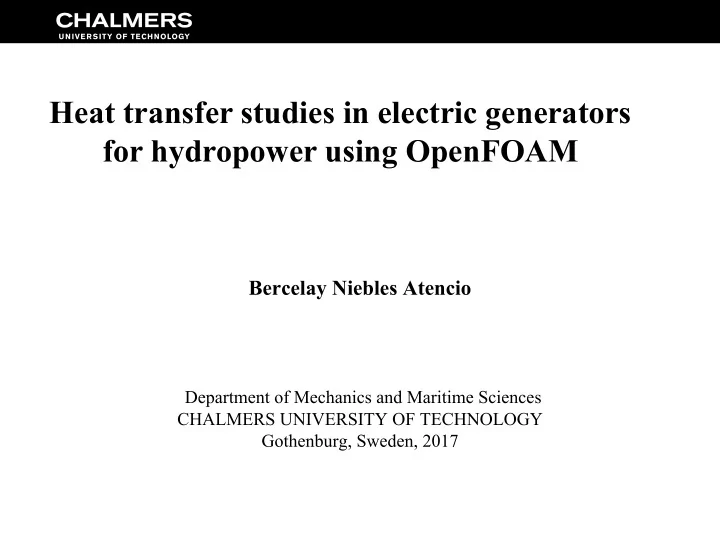

Heat transfer studies in electric generators for hydropower using OpenFOAM Bercelay Niebles Atencio Department of Mechanics and Maritime Sciences CHALMERS UNIVERSITY OF TECHNOLOGY Gothenburg, Sweden, 2017
Electric Generator Design Currently - Design phase of electric generatos relies on empirical correlations (network models). - Large uncertainties (up to 25% error). - Flow of cooling air has been studied in the past. - Many studies focused on flow, thermal models, few experiments. - Nothing done in openFOAM regarding heat transfer in hydrogenerators .
Electric Generators for Hydropower Sketch of an electric generator for hydropower. Source: http://www.eternoohydro.com/hydro-generator/
Solvers in openFOAM - Conjugate heat transfer processes: chtMultiRegionSimpleFoam - Rotation of fluid: MRFSimpleFoam
Code Modification • Use chtMultiRegionSimpleFoam as base sover • Addition of rotation • Addition of heat source terms in heat equation for solids • Test
Testing the code modification
Temperature Boundary Conditions T
With Heat Source term Heat
Network Models Stator Core Rotor Outer Inner - One slot -Heat generation (coil, core) -No rotation -Periodicity and symmetry
CFD for Network Model Case Nusselt Number Re CFD Gnielinksi Dittus-Boelter 3152 15.7 7.9 12 3520 16.8 9.1 13 3960 17.5 10.4 14.3
CFD for SVANTE • Run for different Re • Run for different heat sources • Post-processing • Find correlation Nu, Re and Pr? • Compare with correlations in Network Models
Hydro-generator model experimental rig
Experiments Naphthalene Sublimation Technique Air passage Top Bottom
Naphthalene Sublimation Naphthalene
Simulations for the hydro-generator model Inlet -Inlet, rotor, stator cellZones -kOmegaSST – low Re Rotor -MRFSimpleFoam + heat Stator -Periodic -Mixing Plane -Flow field -Heat transfer in stator channels
Simulations
Thank you!
Recommend
More recommend